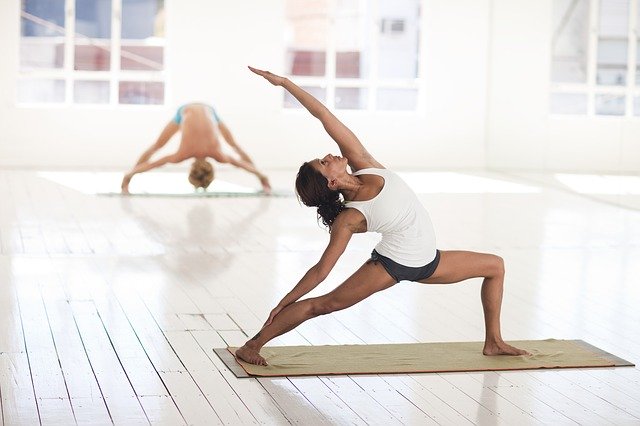By now, you’ve heard all about the benefits of yoga: A regular yoga practice can lead to better sleep, lower stress levels reduced blood pressure, and increased flexibility and strength.
But, if you’re not careful, yoga can also cause injury, particularly to your wrists, lower back, shoulders, elbows, knees, hamstrings, and neck. As with any physical activity, the safest approach to yoga is to learn how to practice the poses correctly.
- Wrists: When it comes to the wrists, it’s all about leverage. Placing all of the body’s weight in the wrists when the hands are on the mat can lead to muscle and joint injuries.
- Find relief: When in doubt, spread ‘em. In any pose where weight is placed on the hands (such as a down dog), distribute the body’s weight through both hands by spreading them wide and pressing through the fingers. In down dog, push the hips back to decrease the angle of the wrists to the floor. In arm balances, such as crow pose, look to see that the elbows are stacked directly over the wrists.
- Elbows: Joint pain in the elbows can result from bending them out to the sides in poses like chaturanga. While it may be easier to execute, lowering down with outward-pointing elbows can stress the joint and can also put undue stresses on the wrists.
- Tuck and lower: When bending the elbows in a pose (particularly plank or chaturanga), keep the elbows tucked alongside the ribs as you bend them, and make sure the elbows’ creases face forward. If this is difficult (yes, it’s a serious test of triceps strength!), begin with the knees on the floor. Remember, you can always work up to the unmodified version through regular practice.
- Shoulders: Beware the shrug. By raising the shoulders up toward the ears (like when moving into an up dog), yogis stop using the supporting muscles in the arms, shoulders, and neck. Shrugging also compresses the shoulders, which can cause muscle injuries. Even worse: It’s easy to injure the shoulder girdle or rotator cuff (and even dislocate the joint) by over-extending or over-stretching.
- Let go: Be careful not to pull too hard on the shoulders in stretches, and always keep the shoulders held back and down away from the ears.
- Ribs: Twists are awesome for releasing the tension, but if done improperly they can overextend or bruise the intercostal muscles (the muscles in between the ribs).
- Twist, don’t shout: Lengthen upwards through the spine before twisting. Imagine that someone has a string attached to the crown of your head and is very gently pulling you up toward the ceiling. Twist to the point of feeling a stretch but not past it, even if you’re flexible.
- Lower back: Lower back pain is the most frequently cited yoga injury, and teachers speculate that it’s likely the result of rounding through the spine in poses like forwarding folds and down dog. Rounding causes the spine to flex the opposite way that it’s supposed to, which can cause disc problems in addition to that achy feeling post-class.
- Soothe the spine: Before bending, imagine lengthening the spine up and away from the hips to avoid rounding. Still, struggling to stay on the straight and narrow? Try bending the knees in poses like forwarding folds and down dog, since the culprit could be tight hamstrings. During seated forward folds, try sitting on a blanket or block to take the pressure off the lower back.
- Hamstrings: Spend most days sitting in front of the computer, in class, or in the car? Guilty as charged. As a result, many of us have tight hamstrings, so it’s easy to pull or over-stretch them in poses like forwarding bends.
- Hamper pain: Down dog and lunges are great ways to stretch the hamstrings (just remember to go slowly and work at your own pace). If you have any kind of hamstring injury, try lying off poses that extend through the back of the body and legs until the injury heals.
- Hips: It’s easy to over-extend the hips’ range of motion in splits, warrior poses, and wide-legged forward folds, which might tear the muscles of the inner groin or inner thighs.
- Get hip (to proper form): A good rule of thumb is to make sure that the toes are pointed forward in any pose where the hips are squared off in the same direction (think: warrior I). Imagine there are headlights attached to the front of the hips and that you’re trying to keep the area straight ahead of you illuminated at all times.
- Knee: Knee issues can plague even experienced yogis, a common culprit of pain is the cross-legged position. Flexibility carries from the hips first; if the hips are tight in the pose, the knees will be the first place to feel pain or tension.
- Prevent the pain: For those regularly bothered by knee pain, avoid sitting in a cross-legged position or full lotus for long periods unless the hips are already very flexible. Placing a block or rolled-up blanket under the knees in cross-legged positions can also help reduce strain. Any time the knee is bent in a standing pose (such as warriors I and II), look to see that there’s a vertical line from the bent knee to the heel, this ensures that the body is bearing weight properly.